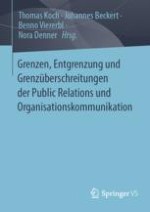2023 | OriginalPaper | Chapter
Churnalism aus Leserperspektive: Glaubwürdigkeits- und Legitimitätseffekte grenzüberschreitender Public Relations
Author : Irina Lock
Published in: Grenzen, Entgrenzung und Grenzüberschreitungen der Public Relations und Organisationskommunikation
Publisher: Springer Fachmedien Wiesbaden
Activate our intelligent search to find suitable subject content or patents.
Select sections of text to find matching patents with Artificial Intelligence. powered by
Select sections of text to find additional relevant content using AI-assisted search. powered by
